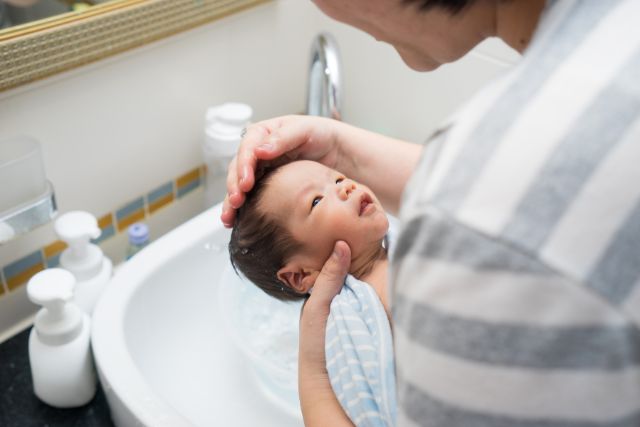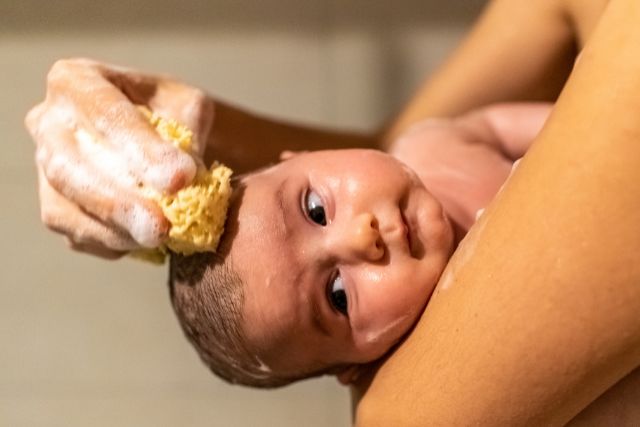Discover the essentials of newborn bath time with our expert tips and guidance. Learn the right techniques, safety precautions, and must-have products for a gentle and enjoyable bathing experience for your precious little one.
While hearing your newborn’s first cry usually sounds like a sweet melody to your ears, a baby’s first bath may not sound so sweet.
As a new mother, you may feel worried over many issues. Can my baby slide in the tub? Is there a possibility of accidentally drinking bathing water? Or how do I hold him?
All these concerns and frustrations about your baby’s first bath may make you want to hire a baby washer!
But wait,
Is a newborn’s first bath worthy of all these worries? Definitely not. And even though it’s not easy, you shouldn’t worry, mama; so many women can relate. We went through these life seasons, and we managed!
Today, I want to tackle some of your questions concerning your baby’s first bath.
Let’s dive right in.
Affiliate Disclosure: As an Amazon Associate, I get a small commission for purchases made from Amazon.com through links in this post. Learn more about our affiliate disclaimer here.
Newborn Bath After Delivery

When should a newborn have his first bath?
According to WHO, a newborn baby’s first bath should be delayed until 24 hours after delivery. If this is not possible due to lifestyle or health parameters, you need to wait at least six hours before bathing your newborn.
After childbirth, you may notice wax coating around your baby. This is called Vernix caseosa. It is a natural moisturizer with antibacterial qualities which are produced to protect a baby during development and a few hours after birth.
Delaying the first bath is thus essential to protect the vernix, which helps your baby’s skin stay soft, healthy, and clean.
Likewise, delaying a newborn’s bath for at least 24 hours serves to guard against a sudden drop in the baby’s body temperature.
You understand that the baby has been in a different environment (the womb), and as such, you want to allow him time to adjust to the new environment. A sudden drop in body temperature may cause minor stress in babies, leading to a decline in blood sugar.
Also, you do not want to miss the baby-mommy afterbirth bonding time. And that is what bath time does for you—taking a newborn away for a bath too soon after delivery interferes with parent-child, skin-to-skin bonding time.
Bathing Methods for Newborn Bath

While every mother has an intuitive way of newborn bath, two methods are widely known. Full baths and sponge baths.
Which bathing method is appropriate for a newborn?
A sponge bath is the most preferred bathing method for newborns in the first 2 weeks or at least before the drying and falling of the umbilical cord stump.
You do not want to wet the baby’s belly button often and delay the healing of the umbilical cord. And that is why sticking to sponge baths can be a great way of refreshing your baby while speeding the healing and recovery of the belly button.
Can my baby have a full bath before the umbilical cord falls off?
The American Academy of Pediatricians recommends giving your baby sponge baths until the umbilical stump cord falls off.
The stump cord will typically fall off within the first or second week after childbirth.
Sponge bathing your newborn ensures that the umbilical cord remains clean and dry, thus heals faster.
If it doesn’t fall within the stipulated time, there might be other underlying health issues, and it’s important to seek medication.
But that is not to say that your baby should not have full baths. You can still do a full bath once in a while.
Related: How Best Can You Care For Your Baby’s Umbilical Cord After Birth?
Here is a Step by Step Guide on How to Sponge bath a Baby
1. Prepare a warm bathing space free from drafts of air or wind
2. Get your supplies ready before you begin. Your newborn’s sponge bath supplies may include:
- a large bowl of warm water
- a towel
- A soft washcloths for newborns
- gentle baby soap
- clean diapers
- clean worm clothes
- a worm baby shawl
3. Lay your baby on a flat, comfortable, warm surface. The surface may be raised, such as a changing table or a bed. You may use some safety straps to prevent the baby from falling if you’re still moving around.
4. Get the bathing water ready in a large bowl.
5. Dip the washcloth into the water and wipe your baby’s face, concentrating on the eyes and ears.
6. Squeeze a few drops of bathing soap onto the washcloth. Gently wipe your baby’s hair, scalp, and neck. Pat the areas dry.
7. Gently wipe the rest of the baby’s body, paying attention to the armpits, diaper, and genital areas, especially if she is a girl. Be sure to wipe in between the fingers and toes with the soapy washcloth.
8. Now rinse off the soap from the washcloth and wipe off the baby using a clean unsoapy cloth.
9. Ensure your baby remains warm during the sponge bath. You can do this by wrapping him in a warm towel and uncovering the parts you are actively cleaning.
Bathing the Baby After the Umbilical Stump Cord has Fallen Off
Sponge baths are essential before the umbilical stump falls off. Afterward, your newborn is free to have a full bath. Unlike a sponge bath where you use a wet washcloth to wipe the baby’s body, a full bath entails wholesome emersion into a bath tap.
When is your baby ready for a full bath?
Your baby is ready for a full bath after the fall of the umbilical stump. Once the umbilical stump is healed, you can give your baby a full and regular bath in the bathtub.
The first baths should be as brief as possible. You do not want to expose a newborn to the cold for long hours.
Also, make sure that the afterbath supplies like towels and baby shawls are ready so that you can keep the baby worm immediately.
How do you bathe an infant for the first time?
Newborns are usually tiny and delicate; thus, bathing them for the first time can be tricky, especially if you are a first-time mother. Here are tips that you need to consider when preparing for full baby baths.
- Establish a routine. Come up with a definite time of the day when your baby should take a bath. You may consider morning or evening before bedtime. However, ensure you remain consistent with whichever bath timings you have chosen. Establishing a bathing routine can help relax your baby’s body and get them ready for the next course of action, like sleeping.
- Have a designated bathing space. Decide whether you will bathe your baby in the bedroom or shared bathroom. Whatever room you may consider choosing, always keep it warm, safe, and with enough lighting. The baby bathing supplies should also be easily accessible.
- Get your supplies ready. Since it’s never safe to leave your baby in a bathtub alone, you should ensure that everything you will need is ready and well put in its designated places. The bathing essentials may include; bathing soap and shampoo, washcloths, cotton balls, a baby towel, and a plastic basin. The baby’s changing clothes and diapers should also be ready.
- Use baby-friendly products. If you incorporate bathing essentials like soaps and shampoos, ensure that you use mild and quality products. Your baby’s skin is still delicate, and you do not want to try products you aren’t sure about. Using hash products may irritate your baby’s skin and leave it dry. If not sure, why don’t you consider using pediatric recommended products?
- Please don’t force it. Some babies dislike having a full bath. You may devise some distraction measures to keep him calm if this happens. You can use pacifiers or soft music for destruction. You may also try alternating sponge baths with regular baths until they get used to it.
- Make your baby’s safety a priority. Ensure that the bathing room is lip free to reduce the chances of accidents. Never leave a baby without support. Always keep at least one hand on her body at all times. If you’ve forgotten something, always ask for help from someone close to minimizing movement or leaving the baby unattended. Put a known slip bath mat.
- Get a grip correctly. Hold your baby gently but firmly to prevent falling, especially when sliding them into the bath. Be sure to support the head as it may still be too weak to stand independently.
- Do not use a lot of shampoo in the water. Babies do not need a lot of soap, and such use your bathing shampoo sparingly. Sometimes is even okay to use plain water.
Related: 7 Unwritten Baby Routines That Sustained My Sanity In The First 3 Months After ChildBirth
9 Best Baby Soap and Shampoos (According to Dermatologist)
How to Bathe a Newborn Baby

Once, you’ve set up the bathing station, and the supplies are ready; it’s now time for actual action.
- Fill the bathtub or a baby basin with a small amount of water. It can be 3 inches high or somewhere that covers your baby’s belly button.
- Ensure that the water is warm, about 37°C or 38°C. You may measure the temperature with the thermometer or use your elbow or wrist to check the temperature.
- Gently undress your baby.
- Gently lower your baby into the bathtub, with one hand supporting the neck and the head while the other hand is supporting the rest of the body. Ensure you keep the head and the neck above the water. Only submerge the lower body part of the baby. You may use bath support essential to make the process easier.
- If bathing your baby in the big bathtub, ensure you get a comfortable position. You may consider kneeling on a non-slip mat or sitting on a low stool to avoid hurting your back.
- Start by splashing a little water on their tummy to warm up as you engage them with songs or talks.
- Start by cleaning their face, emphasizing the eyes, nose, and ears using a soft cotton washcloth. You want to deal with the face first before the water becomes soapy.
- Shampoo your baby’s hair and gently pour water to rinse the hair using your cupped hand or a bowl/ rinse cup. Be sure to hold your baby in a slanting position to avoid the soap or shampoo dripping into his face.
- Use the soapy water and the washcloth to clean the rest of the body. You may start with hands, wash through the armpits and between the fingers. Be sure to turn your baby over and wash the back, diaper areas like the bottom, and genitals. Wash your baby’s feet and in-between the toes.
- Rinse the whole body once more time to clean off the soap.
- Gently lift your baby out of the bathtub. Wrap your baby in a soft baby towel, preferably with a hood to keep them warm.
How do you dry and dress up a newborn after a bath?
The baby bathing process does not end when you lift them out of the water. You need to ensure that your baby is comfortable and warmly dressed. To effectively do this;
- Gently lay your baby on the dressing mat and pat him dry using the soft towel. Be sure to thoroughly dry her neck, behind the ears, between the fingers & toes, bottom, and anywhere with folded skin. The places, as mentioned earlier, should be kept dry at all times to prevent cuts.
- Use a mild lotion or massage oil like pure coconut to massage your baby gently. Apply the oil to his face, hair, scalp, and body for softness and relaxation.
- Diaper and dress. Roll on a clean diaper before dressing your baby in clean, warm clothes. Swaddling him up in a blanket will be a great option if she needs a little soothing after the bath.
The Dos and Don’ts When Bathing a Newborn
- Always keep the bathing sessions brief, not more than 10 mins, for minimum exposure of your newborn to colds.
- Check the water temperatures before sliding your baby into the tub using your wrist or elbow.
- Use non-slip bathroom mats to reduce the risk of slipping and falling in case of water spillage and slippery floor.
- At any given time, be sure to keep one hand on your baby.
- Never leave your baby alone in any amount of water.
- Always ensure you get a good grip on your baby to prevent falling. Sometimes handling a wet, soapy, slippery newborn can be challenging, but with practice, you will get there, mama.
How often should you bathe your newborn?
Whereas there are no written rules on how often you should bathe your newborn, two things are crucial to guide you—the prevailing weather condition and how dirty you feel your baby might be.
Unless your baby is crawling the whole day in the dust, there is no point in getting stressed with their bath. Bathing your baby once a day, three times a week is enough to keep them clean and relaxed.
Likewise, you may skip washing your baby on cold days to prevent them from chilling. If you consider limiting the number of full baths, you may go the sponge bathe way. It’s equally effective for cleaning and relaxing babies.
How can I check my baby’s bath without a thermometer?
An ideal your baby’s water temperature for bathing should be 37 degrees C to 38 degrees C, which is similar to normal body temperature.
If you do not have a thermometer, you may check the water temperatures using your elbow or wrist. Avoid dipping your hand to gauge the temperature as it may not be accurate. The water should be neither hot nor cold.
Why does my baby get a rash after a bath?
Newborn skin is delicate, and as such, if you use water that is quite hot can cause a rash on your baby’s skin after a bath. The hot water may remove the natural oil from your baby’s skin, making it itchy and dry. Also, try regulating the baby’s body temperature by not overdressing them to avoid such reactions.
How do you keep a baby warm after a bath?
First, ensure that you bathe your baby in an enclosed area, like your bedroom. Ensure that the room is warm by keeping the windows and doors closed to avoid the draft. Have all the supplies, including baby towel and clothe, lined up and within reach before you begin to bathe the baby.
Ensure the bathing time is as short as possible to avoid letting the water cool down too much. When bathtime is over, immediately wrap your baby in a soft fluffy towel and cover their head with a hood. Pat baby dry before dressing them in worm cloths.
Can you bathe a baby twice a day?
Yes, you may bathe your baby twice a day, depending on the prevailing weather and the baby’s condition. Sometimes weather can be too hot, making your baby sweaty and uncomfortable thus, bathing them twice can be a good way of fostering relaxation.
However, under normal circumstances, pediatric associations recommend bathing your baby once a day to reduce exposing their tiny bodies. The baby’s surface area to the body volume ratio is quite large; thus, they can lose heat very fast to their surroundings.
If you have to bathe your baby twice a day, you may consider incorporating quick sponge bathes at least in one session to reduce the risk of chilling or sneezing.
Do newborns need soap in a bath?
There is no problem using soap to bathe a newborn. You may consider using mild and tear-free baby soap or baby shampoos while bathing your baby. Avoid regular soap since it may be too harsh on your baby’s skin.
Should you bathe a baby before or after feedings?
You may bathe your baby before feeding as most kids seem to settle and become drowsy while feeding. These progressive actions can give you an easy time putting your baby to sleep.
If you have to bathe your baby after a feed, always wait for about 30 minutes before doing so. It’s not advisable to bathe your baby straight after a feed as the jostling may make them spit-up. Likewise, do not bathe your baby when hungry or too tired.
Related: 10 Best Ways To Make Bath Times Interesting For Toddlers
Takeaway
Feeling nervous about your newborn baby’s first bath is normal. I mean, bathing a tiny, slippery person is not a joke and may feel daunting at first. Keep learning and practicing, mama; no one was born knowing. With time it is going to be okay.
Here at alltimemommy, we are committed to bringing you helpful information about motherhood. If you found this post helpful, why don’t you click on one or two share buttons and spread the word? I love it when you do so!
Up next:
- Bath Time Made Easy: How To Create a Calm and Stress-free Bath Time For Your Newborn
- 10 Best Bath Toys For Toddlers 1-3 years
